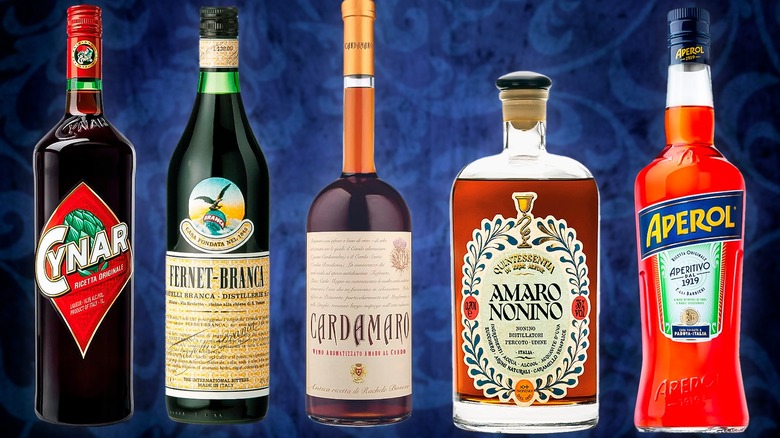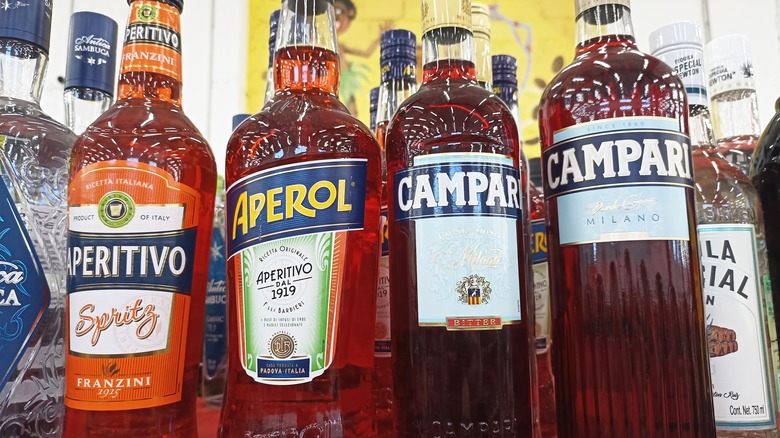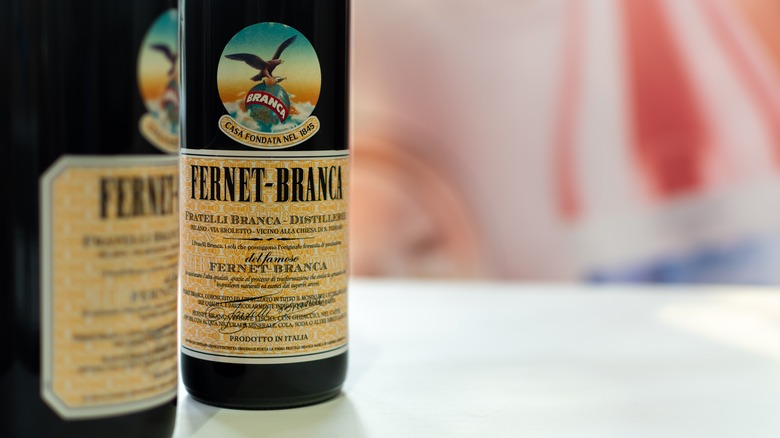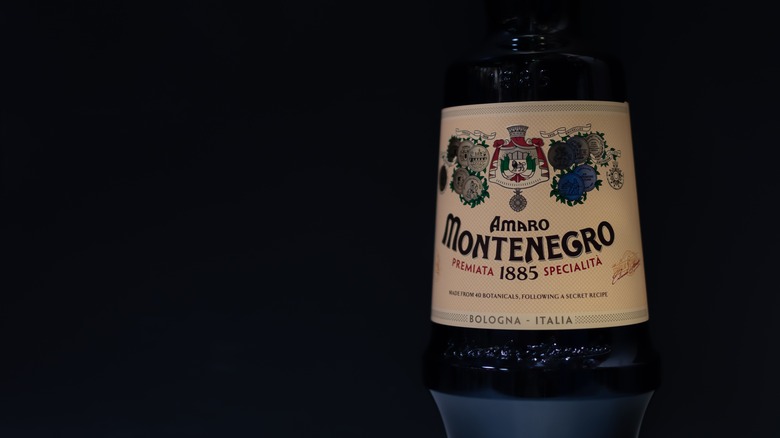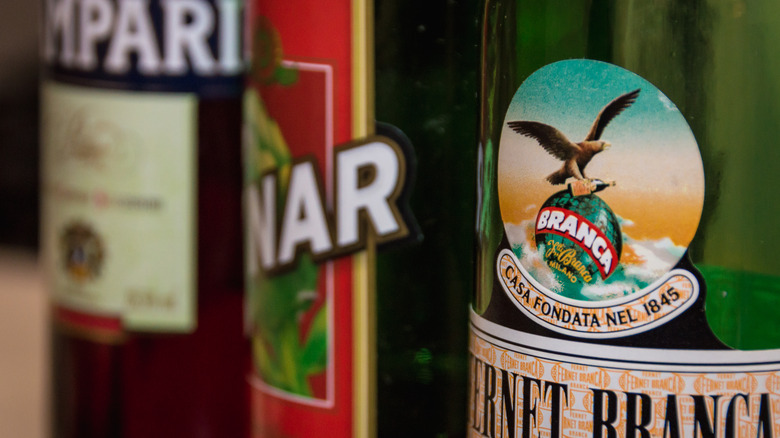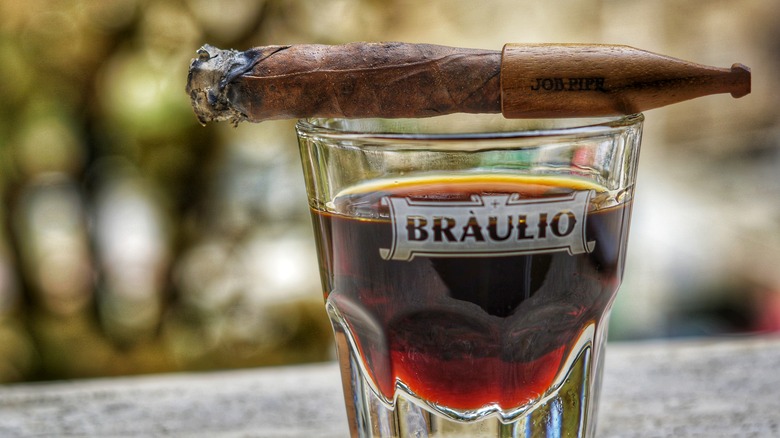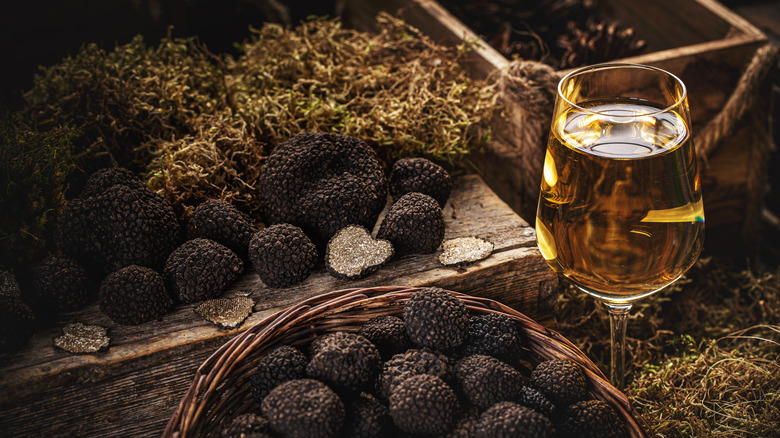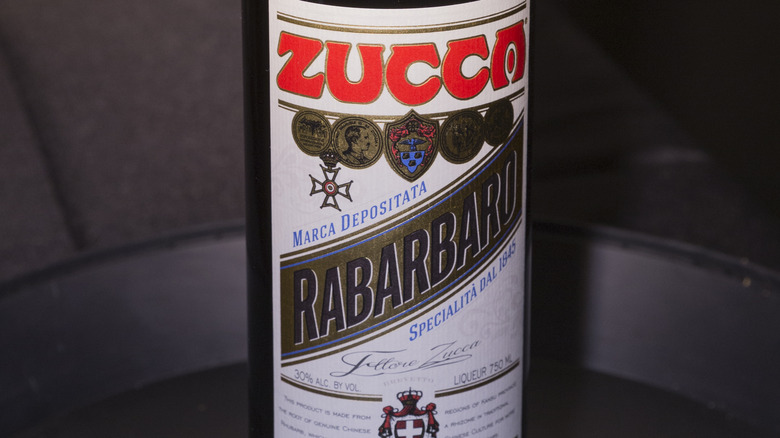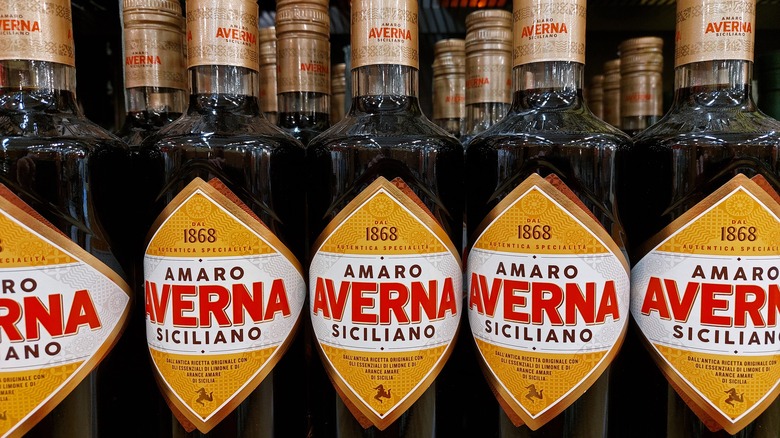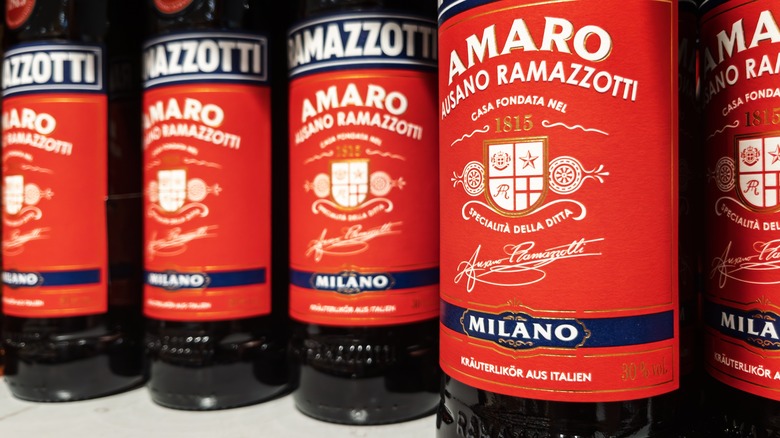11 Types Of Amari, Explained
Built on layers of complexity and botanical aromas, amaro is a broad category of liqueur that mainly involves herbs. Also the Italian word for bitter, the bottled end result is usually some combination of bitter and sweet. While not true in every instance, amaro is served as a digestif, at room temperature, and on its own — save for the orange peel, of course. Amari (the plural form of amaro) come in a variety of distinct styles, though one trademark trait remains: bitterness.
While recipes have been closely guarded for centuries, amaro is typically made by macerating a blend of botanicals, such as herbs, flowers, roots, aromatic bark, and/or citrus peels, and leaving the filtrate to infuse in a neutral spirit. Originally crafted by ancient monks and healers throughout medieval Europe, early amari were medicinal. However, as commercial amaro production ramped up in the 19th century, Italian producers popularized the bittersweet herbal liqueur as brands like Ramazzotti, Amaro Montenegro, and Fernet-Branca rose to prominence. These OG Italian producers continue to be some of the best amari brands on the market, but America's interest in amari — as drinkers and distillers — is only rising.
As a bartender with first-hand experience working in Italian-inspired enotecas, I became very familiar with all of the usual suspects in the amaro line-up. My interest really piqued when I finally opened the obscure one-offs and artisanal bottles that inspired me to experiment with my own bitter infusions in-house. What I quickly learned was there's a seemingly endless and wildly robust offering of amari out there to try. From old-world producers to American-made amari, I've funneled my expertise into a field guide of amari styles for newbie amaro drinker or enthusiasts in need of a quick refresher.
Aperitivo
Aperitivo (or apéritif in French) is an alcoholic beverage that is usually dry and light, and always enjoyed before a meal. The simple choice would be a glass of white wine, or better still, Champagne, but if you really want to do it right, you needn't look any further than Campari. While the bright red spirit is no longer colored with carmine dye derived from cochineal beetles, Campari forever signifies the pre-meal Italian ritual that is aperitivo hour.
A more sophisticated, Milanese interpretation of the American "happy hour," aperitivo hour is about slowing down with a tasty Italian tipple and bar snacks with friends and family. As aperitivi are known to stimulate appetites, it's the perfect time for trying either of Italy's most notorious aperitivi — Campari and Aperol. If drinking a wine-based aperitivo like dry vermouth, I suggest doing as the Europeans do; which is to say, serve it on the rocks, however, the more modern choice — and my personal favorite — is to take your preferred bottle of Ferrari-red spirit and turn it into a spritz.
With the effervescent addition of sparkling wine, the Aperol spritz has become a bona fide classic in the world of aperitivo cocktails. Though, for the classicists out there and/or purists who believe a full-on cocktail is too forward, it's worth noting that carbonation, be it sparkling wine or soda water, will work wonders as a softening agent for Campari's bitterness, as well. The differences between Aperol and Campari may appear as slight as a few shades of orange, Aperol is in fact sweeter and less alcoholic than Campari, making it the more approachable of the bright red, bitter spirits that epitomize the aperitivo style of amaro.
Fernet
A polarizing style of amaro that is revered by service industry folks, Argentines, and courageous palates undeterred by the smell of camphor, when it comes to Fernet, you either love it or you hate it. Whichever way you fall, Fernet is a digestivo amaro known for its medicinal properties and intensely bitter taste. Made from a secret blend of ingredients which consist of myrrh, cinchona, and saffron among many others, Fernet amaro is a digestive aid that can help to settle stomachs, making it the perfect amaro for after-dinner drinking.
Most folks are familiar with Fernet-Branca, not solely because it's historic – its production dates back to 1845 – but because Bernardino Branca's secret recipe has yielded an unmatchable standard other Fernet amaro manufacturers have yet to supersede. But that hasn't stopped craft distillers from trying.
In the world of amari, Fernet's popularity soars far above other well-known styles. While most people seldom think of anything but the OG Fernet-Branca, craft distilleries all across North America have chosen to tackle this complex spirit in their own ways, turning one infamous bottle into a distinct category of amaro.
Light/Medium
Whether you're an entry level amaro drinker or someone who simply prefers a lighter style, Amaro Montenegro and Amaro Nonino are two commendable options for becoming acquainted with the infamous herbal elixir. Both options offer all the complexity that amaro is known for without the medicinal aftertaste, making this style a popular choice among mixologists looking for added depth in their cocktails. Look no further than the Paper Plane cocktail, a contemporary classic that's layered with not just one, but two amari — Aperol and Amaro Nonino.
Amaro Nonino has been made using alpine herbs from the Italian region of Friuli since 1992, and its silky smooth texture may have something to do with the Nonino family's reputation as acclaimed producers of grappa. Whatever it may be, Amaro Nonino is copper hued with top notes of peppery citrus and vanilla. Amaro Montenegro is lighter still, showcasing delicate notes of citrus, rosewater, and sweet clove. This bottle is not only bartender's best friend, as the lightest and gentlest of amari, it's no surprise that Amaro Montenegro was named after an Italian Princess.
While Amaro Montenegro and Amaro Nonino are simply two suggestions to get you started, light- and medium-style amari are among the most abundant offerings available, so there's no reason to feel bitter about your taste bud's preferences.
Carciofo
Carciofo amaro means "bitter artichoke" in Italian, which is quite fitting since this style of amaro prominently features artichoke. As the main ingredient, artichokes (or their leaves) imbue the bitter spirit with a savory vegetal backbone and a balanced ratio of bitterness to sweetness. The end result is dark brown in color, similar to that of Fernet, although the complexity of Carciofo amaro is generally more layered than its bracingly bitter counterpart. That, and its refined richness, makes Carciofo amaro a worthy choice when it comes to crafting cocktails.
Based in Brooklyn, Faccia Brutto produces a fleet of old-world Italian spirits, and their natural and organic Carciofo amaro is a select choice. While there are many more craft distilleries creating their own amaro in this style, the most renowned producer of Carciofo amaro is Cynar. Notable for its earthy, herbaceous taste and ubiquity in cocktail bars, if you haven't noticed the image of an artichoke set behind the brand name on the bottle's Christmas-colored, diamond-shaped label, well, now you know why it's there.
Alpine
Alpine amari gets its distinct flavor profile from high-elevation botanicals such as gentian and juniper, marking this style of amaro with a distinguished character that's built on a sense of place – the Italian side of the Alps. Some of Europe's highest and most extensive mountain ranges are found in the Alps, and over a third of Italy is host to ranges higher than 2,300 feet.
Created in Bormio, close to the Swiss border, Braulio is among the best-known alpine amari. Boasting a mentholated profile underscored by piney notes, the centuries-old Italian spirit earns its rank as a blue ribbon alpine amaro and the perfect summertime sipper. Cooling on the palate, even when imbibed at room temperature, there's no shortage of ways to enjoy Braulio — though I like it best when lengthened with a splash of soda and an orange twist.
Similar to other OG producers in the world of amari, Braulio has provided inspiration to an array of manufacturers eager to create their own versions of alpine amaro. With so many to mention, I'd be remiss if I didn't give a nod to the Cappeletti Family, masters in their own right of traditional Italian liqueurs.
Tartufo
One of the lesser known styles of amari, Tartufo amaro gained popularity during the '80s and '90s, though its production goes back several decades in central Italy. Traditional Tartufo amaro is made with truffles grown and harvested in Umbria, such as Francescano Truffle Amaro, and showcases a woodland flavor profile that is underscored by the soft scent of black truffles.
Similar to Fernet, Tartufo amaro has a licorice-like flavor, is black in color, and is commonly consumed as an after-dinner digestif. However, the latter is bottled at 30% ABV as opposed to Fernet-Branca's 39% ABV, and the unique blend of botanicals used to make Tartufo are grounded by black truffle, one of the most expensive edible mushrooms in the world.
As rich sources of minerals and amino acids, which aid in the regulation of metabolism and bone formation, black truffles augment the medicinal quality and positive health benefits of amaro.
Vino Amaro
Essentially similar to (but not to be conflated with) vermouth, vino amaro is a style that's made from wine instead of neutral spirit — a.k.a. the traditional amari base. This distinction not only brought about the eponymous vino amaro, its creation, somewhat of a pastiche of other amari varietals, also marked a renegade style of amari with close ties to vermouth.
Both vermouth and amari are infused with herbs and botanicals, and considering that vermouth is a fortified, aromatized wine, the delineation between the two gets murky fast. However, this quick and easy guide can help to set them straight: Vermouth comes in two styles, dry and sweet, while vino amaro has but one: bitter.
So, what's a worthwhile vino amaro, you ask? Look no further than the quietly complex, endlessly interesting sipper: Cardamaro. Infused with cardoon and blessed thistle, Cardamaro is a bonafide hit as either an aperitif or digestif; that's because its richness and herbal aromas are evocative of dry vermouth, while the subtle notes of artichoke make for a lighter, gentler version of Cynar.
Rabarbaro
Another amari that's named after its main ingredient, rabarbaro is the Italian word for "rhubarb," and if the mention of the stalky vegetable that's used as a fruit has you salivating for the sweet and tangy flavors of rhubarb pie, then prepare for a rude awakening. Or perhaps, a smoke-filled one.
That's because rabarbaro is made using the rootstock of Chinese rhubarb, which develops a smoky flavor when dried. Combined with a botanical bill that includes orange peel and cardamom, rabarbaro is a bittersweet variety with a flavor that's evocative of sitting around a campfire.
Popular brands include Zucca Rabarbaro, whose recipe originated in 1845 as a result of a homeopathic doctor creating a tincture of rhubarb and medicinal herbs for the wife of Ettore Zucca. While it was intended to help aid digestion, Zucca was so taken by the distinct rhubarb taste that he decided to add alcohol, and well, ecco fatto!
Sweet
Averna is a luscious sipper that's made to savor. While sweet may strike some as overly adulatory when it comes to the bitter Italian spirit, this one-of-a-kind amaro occupies a class of its own, or should I say, island? Ovviamente! That's because Averna hails from Sicily, the largest island in the Mediterranean.
While dark in color, the Sicilian amaro is very approachable, and with a pronounced sweetness and full flavor, it's become known as a gateway amaro. Averna is made to be enjoyed after dinner, either straight or on the rocks, and with prominent citrus notes, make sure you're serving it with an orange peel for full effect. Averna has a thicker texture than other amari, and at 29% ABV, it's also a darling in the cocktail world.
Averna is a key player in this modernized take on the classic Manhattan cocktail. Called the Black Manhattan, it calls for Averna in place of sweet vermouth, which lends the cocktail with an herbaceous bittersweetness that's absent in the original. While the Manhattan is a classic for good reason, once you try it with the Sicilian amaro, you may never go back.
Cola-esque
Named after its resemblance to Coca-Cola — albeit a flat, spiritous, and less sweet interpretation — this style of amari is often dark in color and defined by dominant notes of caramel and baking spices. Common botanicals include wormwood, gentian, and the caffeinated kola nut, all of which allude to cola's dominant characteristics: sweet taste, viscous texture, and zippy finish.
That combination, along with a caldron's worth of secret ingredients, makes for a harmonious blend popularized by a bevy of legacy producers in Italy. The result: a spectrum of cola-esque amari that's almost as plentiful as the two-liter bottles lining the shelves of your local supermarket.
A family-run business for five generations and the winner of Wine Enthusiast's 2024 Spirits Brand of the Year, Meletti is the flagship amaro in this subcategory of perky amari. Perfect for after-dinner imbibing, at 32% ABV, bittersweet, and slightly syrupy, Meletti is the perfect topper to finish an espresso-soaked affogato. Lucano Amaro is more savory still, while CioCiaro offers more viscosity.
Created on the slopes of volcanic Mount Etna in Sicily, Amaro dell'Etna offers a unique "bubblegum cola" flavor and notable minerality that really pops when mixed with seltzer. But of all the bottles in the bunch, Ramazzotti is the most popular writ large, having outsold all producers save for Campari and Aperol. Boasting a sweeter and spicier backbone, Ramazzotti showcases notes of vanilla and dried fruit reminiscent of root beer as opposed to cola.
Unfiltered
Amari in this category tend to refer to a singular producer, Distilleria Varnelli, and its one-of-a-kind blend of amaro, Amaro dell'Erborista. Somewhat reminiscent of alpine amari, Amaro dell'Erborista has a woodsy character that showcases thyme and pine resin with notes of gentian and sandalwood. However, that's where their similarities end; because not only is Amaro dell'Erborista sweetened with honey from the Sibillini Mountains, it's also unfiltered.
Skipping out on filtration means the end result is opaque in appearance, and with brick red shades and a bold tannic structure, the taste is dry, mouth-wateringly intense, and long-lasting. While that description sounds wilder than what most post-meal sippers would want to wind down with, this style does present the perfect opening for introducing a highball into your next aperitivo hour. (Bye-bye spritz.)
While the more common styles of amari are uniformly enjoyed neat, on the rocks, or with a splash of soda, Amaro dell'Erborista is made to be mixed with cola. That's because the sweet caramel flavors of the carbonated soft drink tame the intensity of the unfiltered amaro and create a well-balanced yet wildly herbaceous cocktail with a specialty spirit that's actually good for you.
